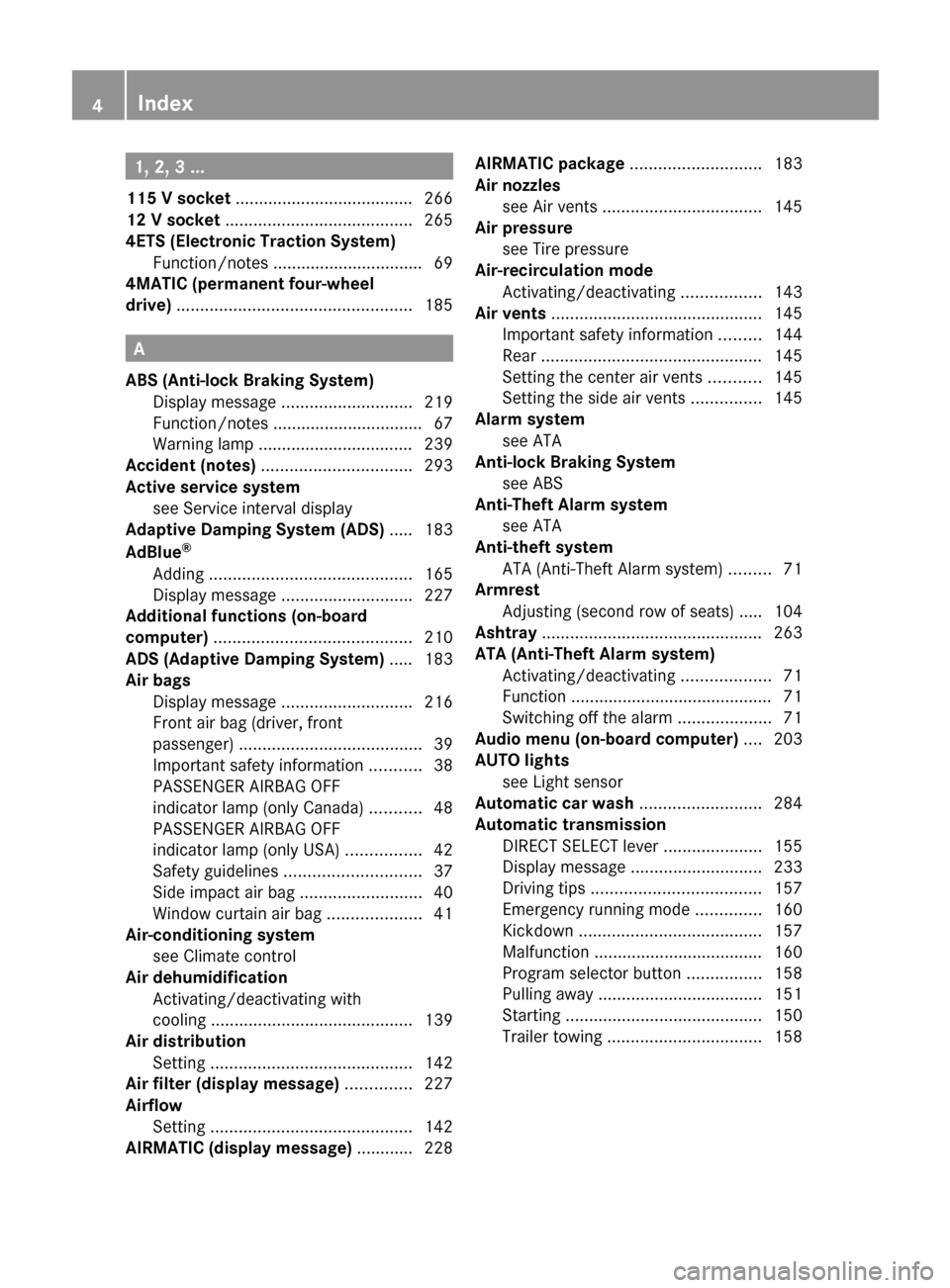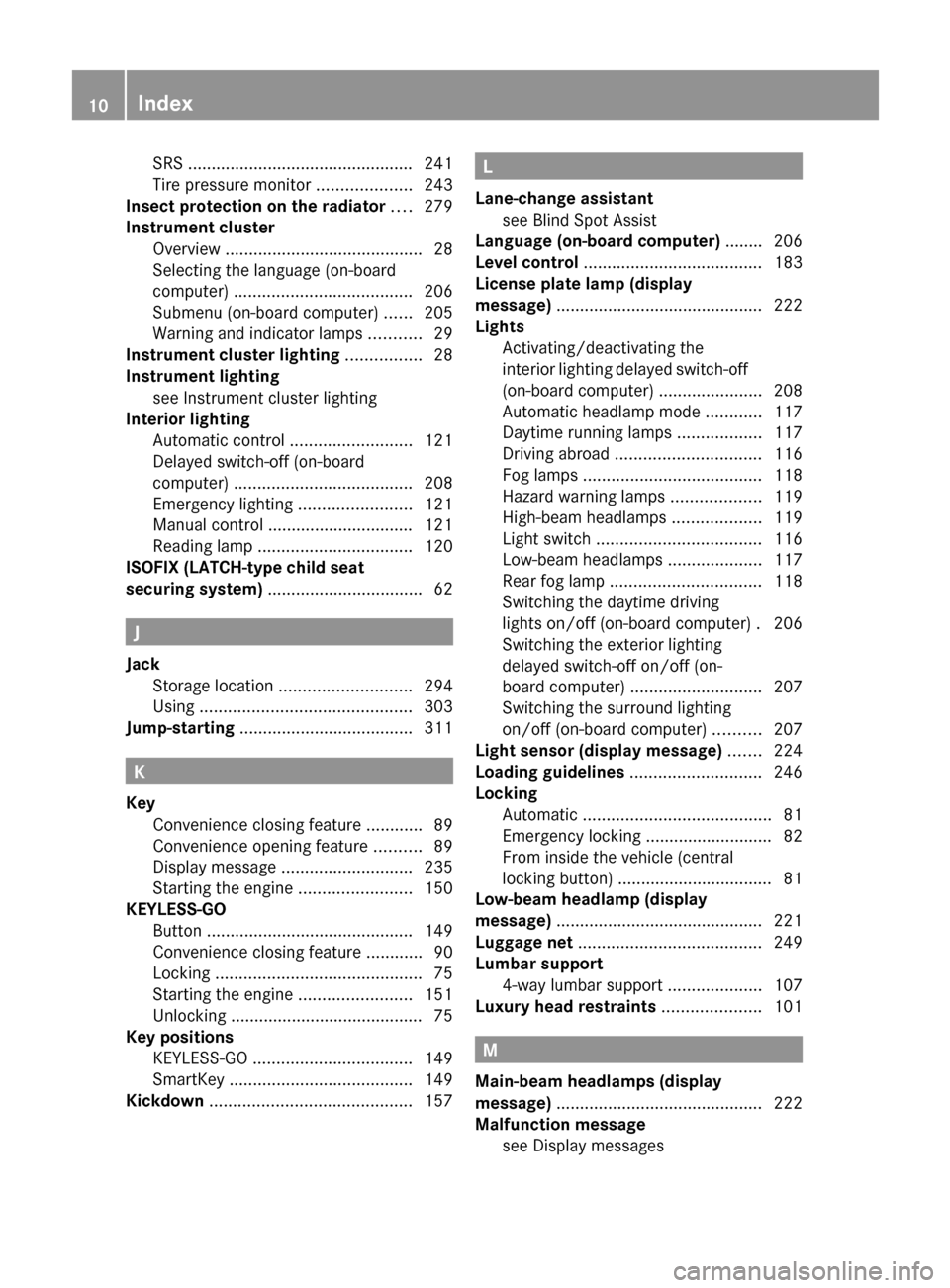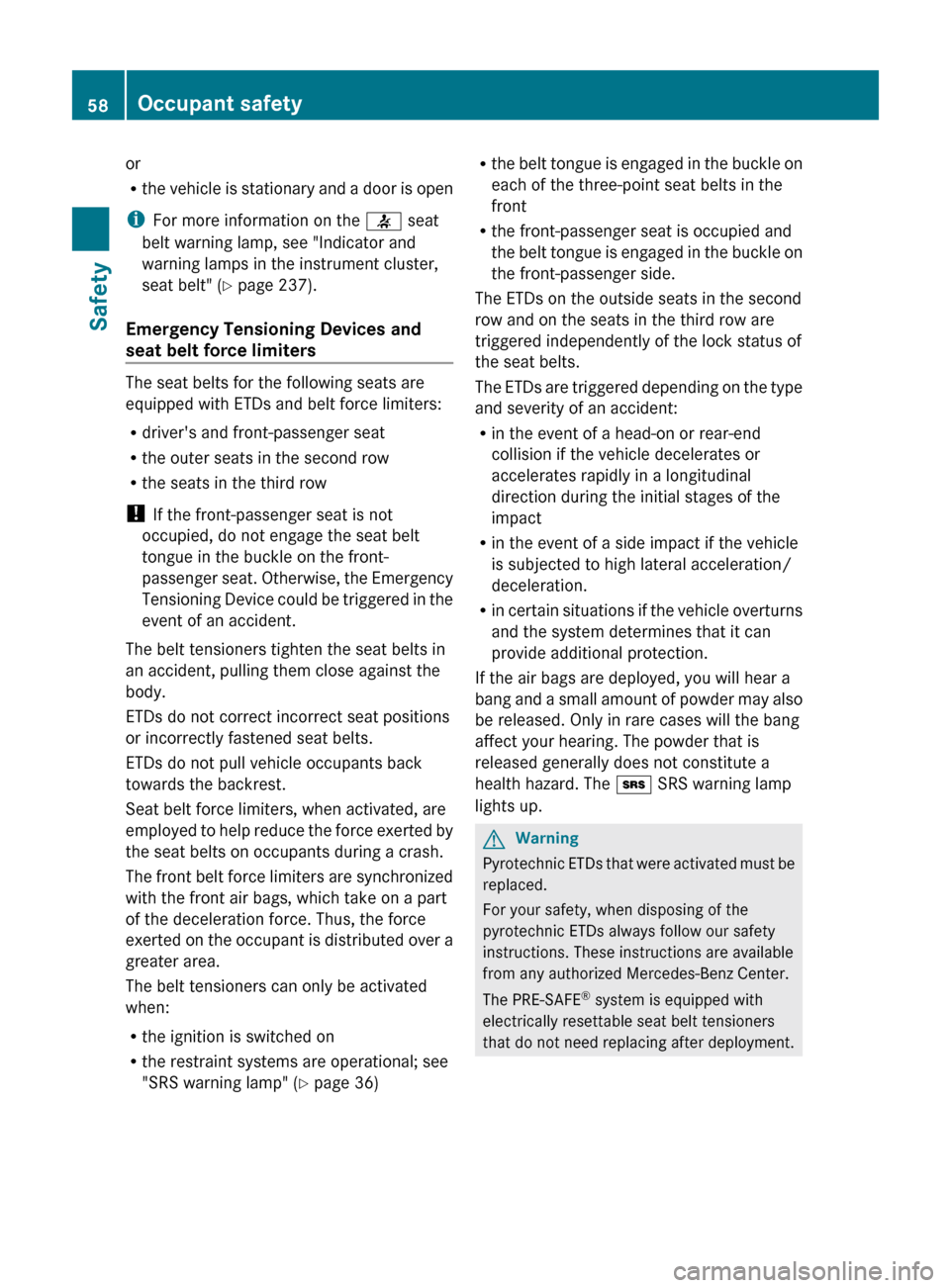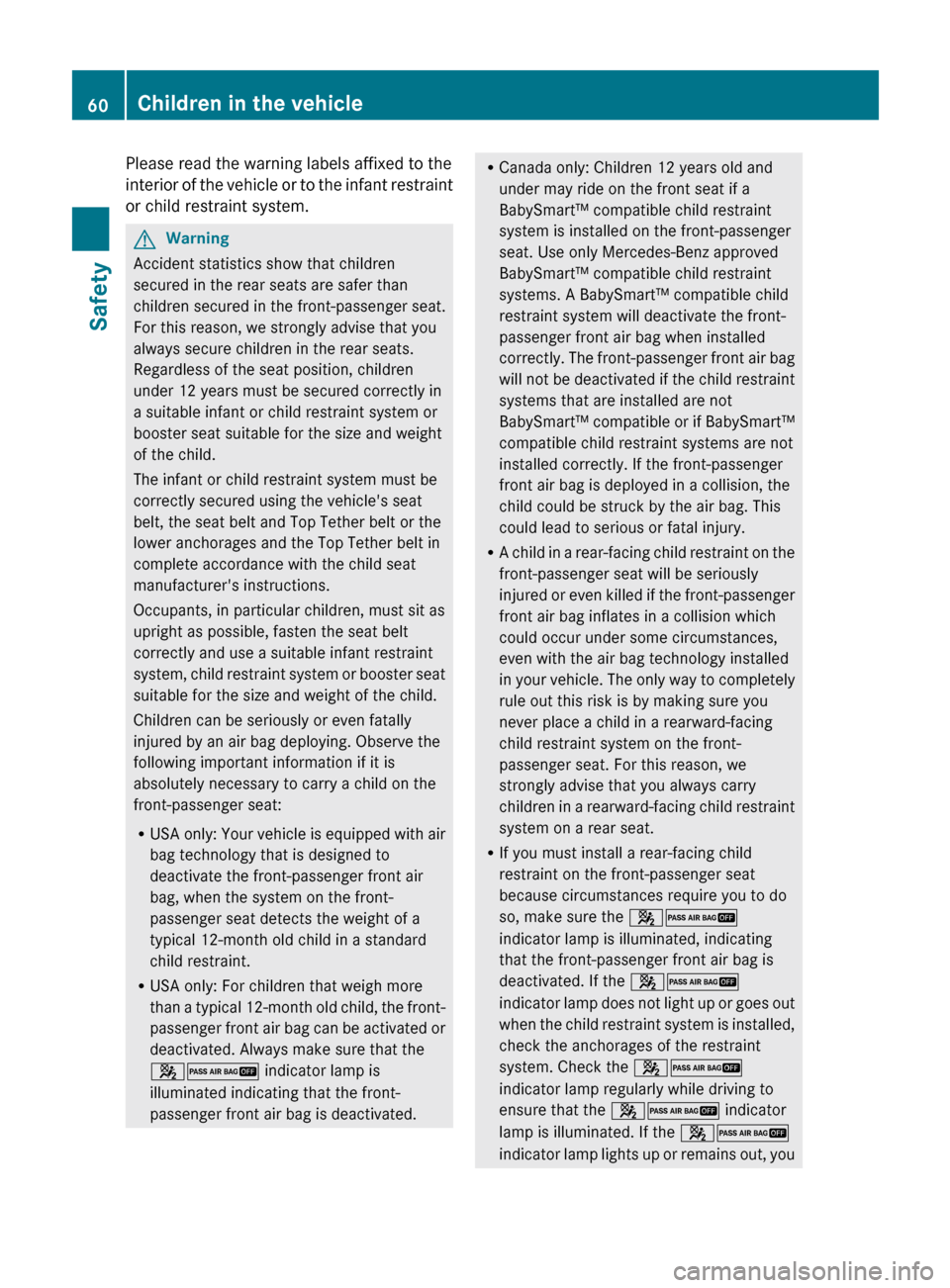warning lights MERCEDES-BENZ R-Class 2011 W251 Owner's Manual
[x] Cancel search | Manufacturer: MERCEDES-BENZ, Model Year: 2011, Model line: R-Class, Model: MERCEDES-BENZ R-Class 2011 W251Pages: 364, PDF Size: 16.5 MB
Page 6 of 364

1, 2, 3 ...
115 V socket ...................................... 266
12 V socket ........................................ 265
4ETS (Electronic Traction System) Function/notes ................................ 69
4MATIC (permanent four-wheel
drive) .................................................. 185
A
ABS (Anti-lock Braking System) Display message ............................ 219
Function/notes ................................ 67
Warning lamp ................................. 239
Accident (notes) ................................ 293
Active service system see Service interval display
Adaptive Damping System (ADS) ..... 183
AdBlue ®
Adding ........................................... 165
Display message ............................ 227
Additional functions (on-board
computer) .......................................... 210
ADS (Adaptive Damping System) ..... 183
Air bags Display message ............................ 216
Front air bag (driver, front
passenger) ....................................... 39
Important safety information ...........38
PASSENGER AIRBAG OFF
indicator lamp (only Canada) ...........48
PASSENGER AIRBAG OFF
indicator lamp (only USA) ................42
Safety guidelines ............................. 37
Side impact air bag ..........................40
Window curtain air bag ....................41
Air-conditioning system
see Climate control
Air dehumidification
Activating/deactivating with
cooling ........................................... 139
Air distribution
Setting ........................................... 142
Air filter (display message) .............. 227
Airflow Setting ........................................... 142
AIRMATIC (display message) ............ 228
AIRMATIC package ............................ 183
Air nozzles see Air vents .................................. 145
Air pressure
see Tire pressure
Air-recirculation mode
Activating/deactivating .................143
Air vents ............................................. 145
Important safety information .........144
Rear ............................................... 145
Setting the center air vents ...........145
Setting the side air vents ...............145
Alarm system
see ATA
Anti-lock Braking System
see ABS
Anti-Theft Alarm system
see ATA
Anti-theft system
ATA (Anti-Theft Alarm system) .........71
Armrest
Adjusting (second row of seats) ..... 104
Ashtray ............................................... 263
ATA (Anti-Theft Alarm system) Activating/deactivating ...................71
Function ........................................... 71
Switching off the alarm ....................71
Audio menu (on-board computer) .... 203
AUTO lights see Light sensor
Automatic car wash .......................... 284
Automatic transmission DIRECT SELECT lever .....................155
Display message ............................ 233
Driving tips .................................... 157
Emergency running mode ..............160
Kickdown ....................................... 157
Malfunction .................................... 160
Program selector button ................158
Pulling away ................................... 151
Starting .......................................... 150
Trailer towing ................................. 1584IndexBA 251 USA, CA Edition A 2011; 1; 3, en-USd2sboikeVersion: 3.0.3.52010-04-16T14:31:55+02:00 - Seite 4
Page 9 of 364

Customer Relations Department ....... 22
D
Dashboard see Cockpit
Date (on-board computer) ................ 206
Daytime driving lights Display message ............................ 223
Switching on/off (on-board
computer) ...................................... 206
Delayed switch-off
Exterior lighting (on-board
computer) ...................................... 207
Interior lighting (on-board
computer) ...................................... 208
Diesel particle filter .......................... 169
Digital speedometer Displaying ...................................... 202
Setting the unit (on-board
computer) ...................................... 205
DIRECT SELECT lever
see Automatic transmission
Display (cleaning instructions) ........ 287
Display messages Brakes ........................................... 219
Calling up (on-board computer) .....213
Clearing (on-board computer) ........213
Driving systems ............................. 228
Engine ............................................ 224
Lamps ............................................ 224
Safety systems .............................. 214
Service interval display ..................282
Tires ............................................... 230
Vehicle ........................................... 233
Distance recorder ............................. 202
Distance warning function
(vehicles with DISTRONIC) ................. 70
Activating/deactivating (on-
board computer) ............................ 210
Distance warning lamp ..................... 243
DISTRONIC ......................................... 175
Display message ............................ 229
Displays in the multifunction
display ........................................... 180
Driving tips .................................... 181
Setting the specified minimum
distance ......................................... 179
Warning lamp ................................. 243
Door
Automatic locking ............................ 81
Automatic locking (on-board
computer) ...................................... 208
Display message ............................ 234
Emergency locking ........................... 82
Emergency unlocking .......................82
Opening (from inside) ......................81
Door control panel
Overview .......................................... 33
Doors
Important safety notes ....................80
Drinking and driving ......................... 169
Drinks holder see Cup holder
Drive program
Automatic ...................................... 158
Driving abroad ................................... 173
Driving on flooded roads .................. 172
Driving safety system EBD (Electronic Brake force
Distribution) ..................................... 70
ESP ®
(Electronic Stability
Program) .......................................... 68
Important safety information ...........67
Driving safety systems
4ETS (Electronic Traction System) ...69
ABS (Anti-lock Braking System) .......67
BAS (Brake Assist System) ..............68
Distance warning system
(vehicles with DISTRONIC) ...............70
Overview .......................................... 67
Driving systems
Blind Spot Assist ............................ 191
Cruise control ................................ 173
DISTRONIC .................................... 175
Level control .................................. 183
PARKTRONIC ................................. 186
Rear axle level control ...................182
Rear view camera .......................... 189
Driving tips ........................................ 157
DISTRONIC .................................... 181
Downhill gradients .........................170
Driving on flooded roads ................172Index7BA 251 USA, CA Edition A 2011; 1; 3, en-USd2sboikeVersion: 3.0.3.52010-04-16T14:31:55+02:00 - Seite 7
Page 10 of 364

Towing a trailer .............................. 193
Wet road surface ........................... 170
Winter ............................................ 172
DVD audio (on-board computer) ...... 203
E
EASY-ENTRY feature ......................... 110
3rd row of seats ............................. 105
Activating/deactivating (on-
board computer) ............................ 209
EASY-EXIT feature ............................. 110
3rd row of seats ............................. 105
Crash-responsive ........................... 111
EBD (Electronic Brake force
Distribution) Display message ............................ 220
Function/notes ................................ 70
Electrical fuses
see Fuses
Electronic Brake-force
Distribution) see EBD
Electronic Stability Program
see ESP ®
Electronic Traction Support
see 4ETS
Emergency call
see mbrace
Emergency release
Fuel filler flap ................................. 162
Vehicle ............................................. 82
Emergency running mode
Automatic transmission .................160
Emergency spare wheel
Storage location ............................ 295
Stowing .......................................... 295
Emergency tensioning device
Function ........................................... 58
Safety guidelines ............................. 37
Emissions purification
Service and warranty information ....19
Engine
Irregular running ............................ 154
Starting problems ..........................154
Starting the engine with the key ....150
Starting with KEYLESS GO .............151
Switching off .................................. 152
Warning lamp (engine
diagnostics) ................................... 242
Engine electronics
Malfunction .................................... 154
Engine emergency stop .................... 317
Engine number .................................. 350
Engine oil Adding ........................................... 280
Checking the oil level ..................... 279
Display message ............................ 226
Lubricant additives ........................355
Notes about oil grades ................... 354
Viscosity ........................................ 355
ESP ®
(Electronic Stability
Program) Activating/deactivating ...................69
Display message ............................ 214
Important safety information ...........68
Trailer stabilization ........................... 70
Warning lamp ................................. 240
Exhaust check ................................... 169
Exhaust tail pipe (cleaning
instructions) ...................................... 287
Exterior lighting see Lights
Exterior mirrors
Adjusting ....................................... 112
Dipping (automatic) .......................113
Folding in/out (automatically) .......112
Folding in/out (electrically) ...........112
Folding in when locking (on-board
computer) ...................................... 209
Out of position ............................... 113
Setting ........................................... 112
Storing settings (memory
function) ........................................ 114
Storing the parking position ..........113
Exterior view ........................................ 26
F
Filling capacity see Technical data
First-aid kit ......................................... 293
8IndexBA 251 USA, CA Edition A 2011; 1; 3, en-USd2sboikeVersion: 3.0.3.52010-04-16T14:31:55+02:00 - Seite 8
Page 12 of 364

SRS ................................................ 241
Tire pressure monitor ....................243
Insect protection on the radiator .... 279
Instrument cluster Overview .......................................... 28
Selecting the language (on-board
computer) ...................................... 206
Submenu (on-board computer) ......205
Warning and indicator lamps ...........29
Instrument cluster lighting ................ 28
Instrument lighting see Instrument cluster lighting
Interior lighting
Automatic control ..........................121
Delayed switch-off (on-board
computer) ...................................... 208
Emergency lighting ........................121
Manual control ............................... 121
Reading lamp ................................. 120
ISOFIX (LATCH-type child seat
securing system) ................................. 62
J
Jack Storage location ............................ 294
Using ............................................. 303
Jump-starting ..................................... 311
K
Key Convenience closing feature ............89
Convenience opening feature ..........89
Display message ............................ 235
Starting the engine ........................150
KEYLESS-GO
Button ............................................ 149
Convenience closing feature ............90
Locking ............................................ 75
Starting the engine ........................151
Unlocking ......................................... 75
Key positions
KEYLESS-GO .................................. 149
SmartKey ....................................... 149
Kickdown ........................................... 157
L
Lane-change assistant see Blind Spot Assist
Language (on-board computer) ........ 206
Level control ...................................... 183
License plate lamp (display
message) ............................................ 222
Lights Activating/deactivating the
interior lighting delayed switch-off
(on-board computer) ......................208
Automatic headlamp mode ............117
Daytime running lamps ..................117
Driving abroad ............................... 116
Fog lamps ...................................... 118
Hazard warning lamps ...................119
High-beam headlamps ...................119
Light switch ................................... 116
Low-beam headlamps ....................117
Rear fog lamp ................................ 118
Switching the daytime driving
lights on/off (on-board computer) . 206
Switching the exterior lighting
delayed switch-off on/off (on-
board computer) ............................ 207
Switching the surround lighting
on/off (on-board computer) ..........207
Light sensor (display message) ....... 224
Loading guidelines ............................ 246
Locking Automatic ........................................ 81
Emergency locking ........................... 82
From inside the vehicle (central
locking button) ................................. 81
Low-beam headlamp (display
message) ............................................ 221
Luggage net ....................................... 249
Lumbar support 4-way lumbar support ....................107
Luxury head restraints ..................... 101
M
Main-beam headlamps (display
message) ............................................ 222
Malfunction message see Display messages
10IndexBA 251 USA, CA Edition A 2011; 1; 3, en-USd2sboikeVersion: 3.0.3.52010-04-16T14:31:55+02:00 - Seite 10
Page 31 of 364

Warning and indicator lampsFunctionPage:Brakes (USA only)236;ESP®240=Distance warning lamp 4243?Turn signal119ATurn signal119BDiesel engine: preglow150CSRS241DLow-beam headlamps117EEngine diagnostics (Canada
only)
242
FEngine diagnostics (USA
only)
242
FunctionPageGHigh-beam headlamps119HReserve fuel242ISeat belt237JBrakes (Canada only)236KTire pressure monitor (USA
only)
243
LABS239MThe lamp lights up briefly,
but has no function.4 On vehicles without DISTRONIC, the lamp lights up briefly but has no function.Instrument cluster29At a glanceBA 251 USA, CA Edition A 2011; 1; 3, en-USd2sboikeVersion: 3.0.3.52010-04-16T14:31:55+02:00 - Seite 29
Page 38 of 364

Vehicle equipment
i This manual describes all the standard
and optional equipment of your vehicle
which was available at the time of
purchase. Country-specific differences are
possible. Bear in mind that your vehicle
may not feature all functions described
here. This also refers to safety-related
systems and functions.
Occupant safety
Overview of occupant safety
In this section you will learn the most
important facts about the restraint system
components of the vehicle.
The restraint systems are:
R Seat belts
R Child restraint systems
R "LATCH" type child seat mountings
Additional protection is provided by:
R SRS (Supplemental Restraint System)
R NECK-PRO head restraints
R PRE-SAFE ®
R Air bag system components with:
- PASSENGER air bag OFF indicator lamp
- USA only: front-passenger seat with
Occupant Classification System (OCS)
- Canada only: front-passenger seat with
BabySmart™ air bag deactivation system
The protective functions of the systems work
in conjunction with each other. The systems
are, however, autonomous.
GWarning
Modifications to or work improperly
conducted on restraint system components
or their wiring, as well as tampering with
interconnected electronic systems, can lead
to the restraint systems no longer functioning
as intended.
Air bags or Emergency Tensioning Devices
(ETDs), for example, could deploy
inadvertently or fail to deploy in accidents
although the deceleration threshold for air
bag deployment is exceeded. Therefore,
never modify the restraint systems. Do not
tamper with electronic components or their
software.
i More information on the subject of
children in the vehicle and child restraint
systems can be found under the "Children
in the vehicle" chapter ( Y page 59).
SRS (Supplemental Restraint System)
Introduction
SRS reduces the risk of occupants coming
into contact with the vehicle's interior in the
event of an accident. It can also reduce the
effect of the forces to which occupants are
subjected during an accident.
SRS consists of:
R + SRS warning lamp
R air bags
R air bag control unit (with crash sensors)
R ETDs
R belt force limiters
SRS warning lamps
SRS functions are checked regularly when
you switch on the ignition and when the
engine is running. Therefore, malfunctions
can be detected in good time.
The + SRS warning lamp in the instrument
cluster lights up when the ignition is switched
on. It goes out no later than a few seconds
after the engine is started.
The SRS components are in operational
readiness when the + indicator lamp goes
out while the engine is running.
36Occupant safetySafety
BA 251 USA, CA Edition A 2011; 1; 3, en-USd2sboikeVersion: 3.0.3.52010-04-16T14:31:55+02:00 - Seite 36
Page 59 of 364

on and off in the on-board computer
( Y page 209).
Seat belt outlet height adjustment
You can adjust the seat belt height on the
driver's seat and the front-passenger seat.
Adjust the belt to a height that allows the
upper part of the seat belt to be routed across
the center of your shoulder.
XTo raise: slide the belt sash guide upwards.
The belt sash guide engages in various
positions.XTo lower: press and hold belt sash guide
release :.XSlide the belt sash guide downwards.XRelease belt sash guide release : and
make sure that the belt sash guide has
engaged.
Releasing seat belts
XPress release button ? (Y page 55) and
guide belt tongue ; back towards belt
sash guide :.
!
Make sure that the seat belt is fully rolled
up. Otherwise, the seat belt or belt tongue
will be trapped in the door or in the seat
mechanism. This could damage the door,
the door trim panel and the seat belt.
Damaged seat belts can no longer fulfill
their protective function and must be
replaced. Consult an authorized Mercedes-
Benz Center.
Belt warning for driver and front
passenger
Regardless of whether the driver's and front-
passenger seat belts have already been
fastened, the 7 seat belt warning lamp
lights up for six seconds each time the engine
is started. It then goes out once the driver and
the front passenger have fastened their seat
belts.
If the driver's seat belt is not fastened after
the engine is started, an additional warning
tone will sound. The warning tone goes out
after approximately six seconds or once the
driver's seat belt is fastened.
If after six seconds the driver or front-
passenger have not fastened their seat belts
and the doors are closed:
R the 7 seat belt warning lamp remains
illuminated as long as either the driver's or
front-passenger seat belt is not fastened.
R if the vehicle speed once exceeds 15 mph
(25 km/h), the 7 seat belt warning
lamp lights up. Additionally, a warning tone
will sound with increasing intensity for a
maximum of 60 seconds or until the
driver's and front-passenger seat belt are
fastened.
If the driver/front passenger unfasten their
seat belt while the vehicle is in motion, the
7 seat belt warning lamp lights up and a
warning tone sounds again.
The warning tone ceases even if the driver or
front passenger have still not fastened their
seat belt after 60 seconds. The 7 seat belt
warning lamp stops flashing but continues to
be illuminated.
After the vehicle has come to a standstill, the
warning tone is reactivated and the 7 seat
belt warning lamp flashes again if the vehicle
speed has exceeded 15 mph (25 km/h).
The 7 seat belt warning lamp only goes
out if:
R both the driver and the front passenger
have fastened their seat belts
Occupant safety57SafetyBA 251 USA, CA Edition A 2011; 1; 3, en-USd2sboikeVersion: 3.0.3.52010-04-16T14:31:55+02:00 - Seite 57Z
Page 60 of 364

or
R the vehicle is stationary and a door is open
i For more information on the 7 seat
belt warning lamp, see "Indicator and
warning lamps in the instrument cluster,
seat belt" ( Y page 237).
Emergency Tensioning Devices and
seat belt force limiters
The seat belts for the following seats are
equipped with ETDs and belt force limiters:
R driver's and front-passenger seat
R the outer seats in the second row
R the seats in the third row
! If the front-passenger seat is not
occupied, do not engage the seat belt
tongue in the buckle on the front-
passenger seat. Otherwise, the Emergency
Tensioning Device could be triggered in the
event of an accident.
The belt tensioners tighten the seat belts in
an accident, pulling them close against the
body.
ETDs do not correct incorrect seat positions
or incorrectly fastened seat belts.
ETDs do not pull vehicle occupants back
towards the backrest.
Seat belt force limiters, when activated, are
employed to help reduce the force exerted by
the seat belts on occupants during a crash.
The front belt force limiters are synchronized
with the front air bags, which take on a part
of the deceleration force. Thus, the force
exerted on the occupant is distributed over a
greater area.
The belt tensioners can only be activated
when:
R the ignition is switched on
R the restraint systems are operational; see
"SRS warning lamp" ( Y page 36)
R
the belt tongue is engaged in the buckle on
each of the three-point seat belts in the
front
R the front-passenger seat is occupied and
the belt tongue is engaged in the buckle on
the front-passenger side.
The ETDs on the outside seats in the second
row and on the seats in the third row are
triggered independently of the lock status of
the seat belts.
The ETDs are triggered depending on the type
and severity of an accident:
R in the event of a head-on or rear-end
collision if the vehicle decelerates or
accelerates rapidly in a longitudinal
direction during the initial stages of the
impact
R in the event of a side impact if the vehicle
is subjected to high lateral acceleration/
deceleration.
R in certain situations if the vehicle overturns
and the system determines that it can
provide additional protection.
If the air bags are deployed, you will hear a
bang and a small amount of powder may also
be released. Only in rare cases will the bang
affect your hearing. The powder that is
released generally does not constitute a
health hazard. The + SRS warning lamp
lights up.GWarning
Pyrotechnic ETDs that were activated must be
replaced.
For your safety, when disposing of the
pyrotechnic ETDs always follow our safety
instructions. These instructions are available
from any authorized Mercedes-Benz Center.
The PRE-SAFE ®
system is equipped with
electrically resettable seat belt tensioners
that do not need replacing after deployment.
58Occupant safetySafety
BA 251 USA, CA Edition A 2011; 1; 3, en-USd2sboikeVersion: 3.0.3.52010-04-16T14:31:55+02:00 - Seite 58
Page 62 of 364

Please read the warning labels affixed to the
interior of the vehicle or to the infant restraint
or child restraint system.GWarning
Accident statistics show that children
secured in the rear seats are safer than
children secured in the front-passenger seat.
For this reason, we strongly advise that you
always secure children in the rear seats.
Regardless of the seat position, children
under 12 years must be secured correctly in
a suitable infant or child restraint system or
booster seat suitable for the size and weight
of the child.
The infant or child restraint system must be
correctly secured using the vehicle's seat
belt, the seat belt and Top Tether belt or the
lower anchorages and the Top Tether belt in
complete accordance with the child seat
manufacturer's instructions.
Occupants, in particular children, must sit as
upright as possible, fasten the seat belt
correctly and use a suitable infant restraint
system, child restraint system or booster seat
suitable for the size and weight of the child.
Children can be seriously or even fatally
injured by an air bag deploying. Observe the
following important information if it is
absolutely necessary to carry a child on the
front-passenger seat:
R USA only: Your vehicle is equipped with air
bag technology that is designed to
deactivate the front-passenger front air
bag, when the system on the front-
passenger seat detects the weight of a
typical 12-month old child in a standard
child restraint.
R USA only: For children that weigh more
than a typical 12-month old child, the front-
passenger front air bag can be activated or
deactivated. Always make sure that the
42 indicator lamp is
illuminated indicating that the front-
passenger front air bag is deactivated.
R Canada only: Children 12 years old and
under may ride on the front seat if a
BabySmart™ compatible child restraint
system is installed on the front-passenger
seat. Use only Mercedes-Benz approved
BabySmart™ compatible child restraint
systems. A BabySmart™ compatible child
restraint system will deactivate the front-
passenger front air bag when installed
correctly. The front-passenger front air bag
will not be deactivated if the child restraint
systems that are installed are not
BabySmart™ compatible or if BabySmart™
compatible child restraint systems are not
installed correctly. If the front-passenger
front air bag is deployed in a collision, the
child could be struck by the air bag. This
could lead to serious or fatal injury.
R A child in a rear-facing child restraint on the
front-passenger seat will be seriously
injured or even killed if the front-passenger
front air bag inflates in a collision which
could occur under some circumstances,
even with the air bag technology installed
in your vehicle. The only way to completely
rule out this risk is by making sure you
never place a child in a rearward-facing
child restraint system on the front-
passenger seat. For this reason, we
strongly advise that you always carry
children in a rearward-facing child restraint
system on a rear seat.
R If you must install a rear-facing child
restraint on the front-passenger seat
because circumstances require you to do
so, make sure the 42
indicator lamp is illuminated, indicating
that the front-passenger front air bag is
deactivated. If the 42
indicator lamp does not light up or goes out
when the child restraint system is installed,
check the anchorages of the restraint
system. Check the 42
indicator lamp regularly while driving to
ensure that the 42 indicator
lamp is illuminated. If the 42
indicator lamp lights up or remains out, you60Children in the vehicleSafety
BA 251 USA, CA Edition A 2011; 1; 3, en-USd2sboikeVersion: 3.0.3.52010-04-16T14:31:55+02:00 - Seite 60
Page 70 of 364

GWarning!
Do not pump the brake pedal. Use firm, steady
brake pedal pressure instead. Pumping the
brake pedal reduces the braking effect.
ABS regulates brake pressure in such a way
that the wheels do not lock when you brake.
This allows you to continue steering the
vehicle when braking.
ABS works from a speed of about
5 mph (8 km/h) upwards, regardless of road-
surface conditions. ABS works on slippery
surfaces, even when you only brake gently.
The ! warning lamp in the instrument
cluster lights up when the ignition is switched
on. It goes out when the engine is running.
Braking
If ABS intervenes when braking, you will feel
a pulsing in the brake pedal.
XIf ABS intervenes: continue to depress the
brake pedal with force until the braking
situation is over.XTo make a full brake application:
depress the brake pedal with full force.GWarning
If the ABS malfunctions, other driving systems
such as the BAS or the ESP ®
are also switched
off. Observe indicator and warning lamps that
may come on as well as messages in the
multifunction display that may appear.
If the ABS malfunctions, the wheels may lock
during hard braking, reducing the steering
capability and extending the braking distance.
The pulsating brake pedal can be an
indication of hazardous road conditions and
functions as a reminder to take extra care
while driving.
BAS (Brake Assist)GWarning
Observe "Important safety instructions"
( Y page 67).
BAS operates in emergency braking
situations. If you depress the brake pedal
quickly, BAS automatically boosts the braking
force, thus shortening the stopping distance.
XKeep the brake pedal firmly depressed until
the emergency braking situation is over.
ABS prevents the wheels from locking.
The brakes will function as usual once you
release the brake pedal. BAS is deactivated.
GWarning
If the BAS malfunctions, the brake system still
functions, but without the additional brake
boost available that the BAS would normally
provide in an emergency braking maneuver.
Therefore, the braking distance may increase.
ESP ®
(Electronic Stability Program)
Important safety guidelines
GWarning
Observe "Important safety instructions"
( Y page 67).
If ESP ®
detects that the vehicle is deviating
from the direction desired by the driver, one
or more wheels are braked to stabilize the
vehicle. If necessary, the engine output is also
modified to keep the vehicle on the desired
course within physical limits. ESP ®
assists
the driver when pulling away on wet or
slippery roads. ESP ®
can also stabilize the
vehicle during braking.
If ESP ®
intervenes, the d warning lamp
flashes in the instrument cluster.
68Driving safety systemsSafety
BA 251 USA, CA Edition A 2011; 1; 3, en-USd2sboikeVersion: 3.0.3.52010-04-16T14:31:55+02:00 - Seite 68